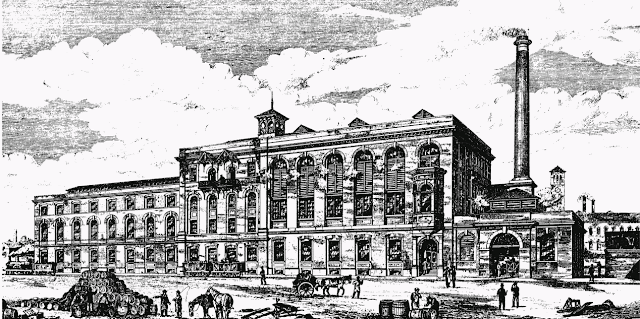It isn’t true that all geologists drink beer. But many do,and I’m one of them. Today I’m going to talk about theintimate connection between geology and beer.
Beer is mostly water, and water chemistry has everything todo with beer styles. And water chemistry itself depends mostly on the kinds ofrocks through which the water flows. You know about hard and soft water – hardwater has more dissolved chemicals like calcium and magnesium in it, and whilesalts of those chemicals can precipitate out of hard water, making a scum onyour dishes, they also can be beneficial to development of bones and teeth. Inthe United States, the Midwest and Great Plains have some of the hardest waterbecause of the abundant limestones there, and in Great Britain, southern andeastern England have harder water than Scotland for similar reasons.
But it wasn’t limestone that made Burton-upon-Trent a centerof brewing in the 19th Century, when it was home to more than 30breweries. The water there is rich in sulfate which comes from gypsum, calciumsulfate, in the sandstone underlying the region. Those sandstones are Permianand Triassic in age, representing a time when much of the earth was arid. Thosedry conditions allowed gypsum to crystallize in the sediments. Gypsum is muchmore soluble than limestone, and the slightly acidic waters of Burton help withthat. Burton water has ten times the calcium, three times the bicarbonate, and14 times the sulfate of Coors’ “Rocky Mountain Spring water” in Colorado. That certainlymakes Coors’ Burton brewery product rather different from that made inColorado.
In fact, the addition of gypsum to beer is called“Burtonization.” This increases the hops flavor, but more important to history,sulfates act as preservatives in beer, enough so that Burton brews of pale alescould survive the long trip to British India, giving us the India Pale Alestyle of beer. Not from India, but brewed with sulfates derived from gypsum inBritain’s rocks.
That slight acidity in Burton’s water depends on the calciumand magnesium content, and also lends itself to extracting sugars from malted barleyin the mashing process. Calcium and magnesium also help yeast to work itsmagic. Today, home brewers can buy “Burton Water Salts” to imitate the productfrom England.
 Truman, Hanbury, Buxton & Co., Black Eagle brewery, Derby Street, Burton-upon-Trent, in 1876,
Truman, Hanbury, Buxton & Co., Black Eagle brewery, Derby Street, Burton-upon-Trent, in 1876,
from University of LondonLess hoppy beers often originated in areas where the sulfatecontent of the water was low. Pilsen in the Czech Republic, home to pilsnerbeer, has almost no sulfate and only 7 parts per million calcium in its water,compared to around 300 for Burton. Pilsen is in an area of metamorphic rocksthat don’t yield the typical hard-water-making elements.
The presence of Carboniferous age limestones in Ireland makewaters that are high in calcium and carbonate, but they lack the sulfate ofnorthern England. Together with other differences, that makes the area aroundDublin ideal for making a stout porter known today as Guinness.
After water, it’s the soil that makes the most difference tobeer. Hops can grow in a wide range of soils, even the decomposed granite wehave here in Butte, but the thick, well-drained soils of Washington and Oregon,weathered from volcanic rocks, make those states the source of 70% of the hopsgrown in the United States.
The surge of craft breweries in the United States has givenrise to some interesting geological names for brews. Great Basin Brewing inReno and Sparks, Nevada, has Ichthyosaur IPA, known as Icky, as well asOrogenesis, a Belgian-style amber ale. Socorro Springs, in New Mexico, brewsIsopod Pale Ale and Obsidian Stout is available from Deschutes in Oregon. You can get Triceratops Double IPA at NinkasiBrewing in Eugene, Oregon, and Pangaea Ale at Dogfish Head in Delaware. Andeven though it’s more chemical than geological, we shouldn’t leave out AtomicAle’s Dysprosium Dunkelweizen, made in Richland, Washington. Dysprosium is arare-earth element found in the phosphate mineral xenotime and other strangerminerals.
San Andreas Brewing Company, near the fault in California, boastsOktoberquake and Aftershock Wheat.
And I’m undoubtedly prejudiced, because I’m the HouseGeologist at Quarry Brewing here in Butte, which probably has the best mineralcollection in a brewery in the United States, but I think their collection ofgeological names for their beers is unexcelled: Shale Pale Ale, Galena Gold,Open Cab Copper, and Gneiss IPA, and seasonals including Albite, Basalt,Bauxite, Calcite, Epidote, Halite, Ironstone, Porphyry, Opal Oktoberfest,Schist Sour, Rhyolite Rye Pale Ale, Pyrite Pilsner, and more. Mia the bartenderand I tried to come up with a fitting name for a 50-50 mix of basalt andgneiss. I wanted it to be charnockite, but we ended up calling it Mia’sMixture.
Next time you enjoy a beer, thank geology!
—Richard I. Gibson
More Geology of Beer
And another from Lisa Rossbacher
Image: Truman, Hanbury, Buxton & Co., Black Eagle brewery,Derby Street, Burton-upon-Trent, in 1876 from University of London
Join Podchaser to...
- Rate podcasts and episodes
- Follow podcasts and creators
- Create podcast and episode lists
- & much more
Episode Tags
Claim and edit this page to your liking.
Unlock more with Podchaser Pro
- Audience Insights
- Contact Information
- Demographics
- Charts
- Sponsor History
- and More!

- Account
- Register
- Log In
- Find Friends
- Resources
- Help Center
- Blog
- API
Podchaser is the ultimate destination for podcast data, search, and discovery. Learn More
- © 2024 Podchaser, Inc.
- Privacy Policy
- Terms of Service
- Contact Us
